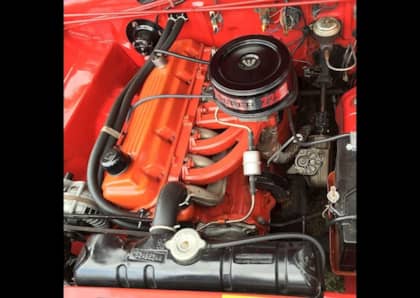Building The Ford 300 Inline 6 Unkillable Engine For Power And Performance In 3 Easy Steps
Ford's 300 cubic inch inline six cylinder engine is one of the world's most popular unkillable engines. With an excellent reputation for reliability and several decades of production, the 300 six has provided millions of truck and van owners with faithful service.
While it might be stout, the 4.9L I6 has never been known as much of a performer, providing solid down-low torque but only middling horsepower in stock form (topping out around 100 ponies and 220 lb-ft of twist in it mightiest iteration). In most applications this isn't an issue, as it was intended to provide affordable towing and hauling capability with modest fuel consumption, and after all it was enough to help a Ford truck win the Baja 1000 no less than three times. Still, those seeking a boost in power have traditionally gone the swap route and dropped one of the many Ford V8 engines that are a direct fit for any 300 CID 6 application.

A growing number of Ford fans, however, are now choosing to walk a different path. In a world where small block V8s are everywhere, building a 300 six for performance is a way to stand out from the crowd. Compared to even 10 years ago, there's a growing amount of aftermarket support for squeezing more horsepower and torque out of this often overlooked engine.
Curious about how to put together a performance build of the Ford 300 inline 6 variety? Here are the 3 steps to take towards building more power.
(Note: we're going to avoid providing specific power gains for each of these mods, as different combinations will yield different results, especially on a motor as bottled-up as the 4.9L six. Consider these as the baseline modifications you'll want to make, and remember that you'll have to tune accordingly to take full advantage of what they bring to the table.)
1. Headers / Exhaust Manifold
One of the biggest roadblocks to making horsepower with the Ford 300 six is its ability to breathe, and one of the easiest ways to improve its lung capacity is by installing a header to replace the stock exhaust manifold. There are a number of different companies that make header designs for the Ford engine, including Hooker, Hedman, and Clifford, with most of these being long tube designs.

There's a major caveat to this advice, however, and it has to do with comparing carbureted to fuel-injected engines. The former will see major benefits with a header installation, but EFI motors are already rocking some very efficient exhaust manifolds and there's no advantage to replacing them. In fact, you'll often see carbureted 300 six projects with EFI manifolds because they're better at managing heat than a long tube header, and are significantly less expensive.

If you're running a full exhaust then an EFI manifold is a good choice across the board. Spending more money on long tube headers for a carb build will see additional gains, while those running forced induction or a full race motor will definitely want to move past the standard manifold. Keep in mind, too, that peak power is only the tip of the iceberg. A good header or manifold upgrade can help an engine churn out more average power across the RPM range than it would have stock, which translates into a better driving experience.
2. Intake Manifold / Carburetor
It's equally important for the Ford 300's intake system to be upgraded in order for it to take full advantage of any exhaust mods. Most aftermarket intakes are geared towards facilitating the replacement of the stock 1-barrel carburetor with a much more effective 4-barrel unit, although it's possible to add a 2-barrel to the stock intake by way of an adapter.

Companies offering 4.9L six intakes include Aussiespeed (both 2 barrel and 4 barrel), Offenhauser (the C Series), Edelbrock Holman Moody, and Clifford (which even features a dual-carb setup). Side draft and down draft manifolds are also available. Not all of these intakes are currently in production, but they are floating around out there in the corner of someone's garage or the top shelf of an auto parts warehouse— if you dig.
We're going to break our rule about 'no specific power predictions' to point out that with the right combination of intake and exhaust, you can easily add 60 to 75 horsepower to the 300 six, along with 50 additional lb-ft of torque. We're mentioning this because that's an astounding 60 percent improvement over stock, given the engine's modest baseline.

It's very possible to over-carb the engine, so don't go too wild when picking a 4-barrel. Make sure it matches the fueling needs of your build. If you're sticking with EFI, you'll be disappointed to find out that factory is your only bet when it comes to intakes.
3. Camshaft
Given that it was offered in so many different applications, it's not surprising that the list of available camshaft grinds for the Ford 300 is long and distinguished. Companies ranging from Comp Cams to Crower to Isky to Crane are out there building streetable camshafts ranging from 206/252 degrees all the way up to 258/292 degrees. Stock, the Ford camshaft for a wide range of 300 I6 trucks is 192/268 degrees.

The most important thing when choosing a camshaft is making sure it matches the type of driving you plan to do. Shifting all of the performance to the high end of the RPM range doesn't make a lot of sense for a street-driven 4.9, given that you'll sacrifice the I6's smooth torque to get there. If you're building a drag car, it's a different story.

Engine compression and the ability to tune to take advantage of the improved lift is also crucial, so if you're an EFI owner you'll want to move to an aftermarket engine management system. Finally, don't forget to upgrade the valvetrain to deal with any additional stress that might be put on it by a more aggressive camshaft.
More From Driving Line
- Curious about other unkillable engines that will run forever? Check out our round-up of the most reliable motors ever built.











